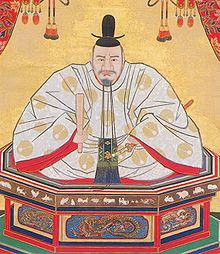- Nabeshima Naoshige
-
In this Japanese name, the family name is "Nabeshima".
Nabeshima Naoshige (鍋島 直茂, April 12, 1537 – July 24, 1619) a retainer of the Ryūzōji clan during the Sengoku period of the 16th century. Naoshige was the son of Nabeshima Kiyosada and was known as Nobumasa throughout half of his career under the Ryūzōji. Naoshige proved himself as being one of the greatest generals under Ryūzōji Takanobu. Following the year of 1570 Naoshige assisted Takanobu while at Saga Castle when it was surrounded by a 60,000-man Ōtomo clan army. However, Naoshige had only 5,000 troops, so he suggested a night raid on the enemies camp which successfully routed them. Following the year of 1575 he attacked Suko Castle in western Hizen and forced its commander, Hirai Tsuneharu, to commit suicide.
In 1584, Nabeshima Naoshige[1] was the chief retainer for the Lord of Hizen until the latter was killed in battle by the forces of the powerful Shimazu clan. After his lord's death, Nabeshima became the true leader of the fiefdom and fought against the Shimazu again in 1587. A Sengoku era warlord, Nabeshima distinguished himself in battle by killing hundreds of men. He was later sent on Hideyoshi's Korean campaigns where he struck up a friendship with Kato Kiyomasa and upon his return to Hizen, Tokugawa Ieyasu.
Naoshige also assisted Takanobu during the Battle of Okitanawate but was unable to prevent their rout which later ended in Takanobu's death. Naoshige took this chance of having a weak heir to leave the Ryūzōji and to support Toyotomi Hideyoshi while during his battle against Kyūshū in 1587. Afterwards much of the Ryūzōji territory which also included the Saga Castle. Naoshige followed in leading over 12,000 men to Korea in the 1st Korean Campaign.
At Sekigahara, Lord Nabeshima's son, Katsushige, was convinced to take sides against Tokugawa Ieyasu. Nabeshima wisely recalled him to attack Tokugawa's enemies in Kyūshū, thus saving the clan from disaster. Historians describe Nabeshima as "a survivor and a man of quick intelligence" who saved his domain from invasion several times.[citation needed] His actions and sayings are immortalized in the third chapter of the Hagakure by writer Tsunetomo Yamamoto, a close attendant of Nabeshima Naoshige's grandson, Mitsushige.
Following the Battle of Sekigahara during the year of 1600 Naoshige sent his son, Nabeshima Katsushige to assist Tokugawa Ieyasu. Following the victory of the Tokugawa, their 357,000-koku fief went untouched by Ieyasu. Following Naoshige's death his family became very well known.
References
External links
Categories:- Samurai
- 1537 births
- 1619 deaths
- Daimyo
- Nabeshima clan
Wikimedia Foundation. 2010.

